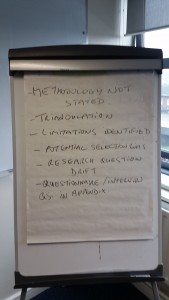The following is a reflection on Week 6 of the Educational Research Design module using Gibbs Reflective Cycle.

Qualitative Methods
Description
Today’s class focused on qualitative methods where research is about depth rather than breadth. It is associated with text whereas quantitative is more associated with numbers. We discussed the validity, reliability and sampling in qualitative research.
Triangulation has reappeared again this week. Triangulation refers to two or more methods used to measure the same variable. It tests that your results are accurate or seem to validate each other. If there is a disparity it may be due to an error in the data gathering or analysis. This will be relevant if I use the mixed methods research.
Feelings
Today was a very productive class with good practical elements. I feel that I have a lot of catching up to do in terms of getting started on my research proposal. However, the last few weeks have enabled us to examine each of the stages and see how our topics will fit into place.
Analysis
While qualitative may involve a lot of work it will be the main method that I will be using in my own research. To ascertain the perceptions of students in answering the research question it can only be achievable with interviews or focus groups. I noticed that three authors were prevalent in the class notes – Cousin, 2009; Bryman, 1988 and Silverman 2010. Therefore it would be worthwhile exploring their work further.
As mentioned in class notes the researcher seeks to experience the phenomenon through the eyes of others and with strong awareness of context – “attention to mundane detail” (Bryman, 1988). As Claire McAvinia explained what may appear mundane or trivial in the research may in fact be important to the participants. When carrying out her research on VLE’s she noticed that many lecturers mentioned photocopying of notes. Initially she thought it was mundane but in fact it kept reappearing in her findings.
We were given an activity in class where we were asked in groups to put together 5 questions for a focus group. It was very challenging due to the time constraints and I believe that giving questions to participants beforehand may be beneficial to yield richer data. Allowing them time to reflect is important and it was mentioned in class that in some cases the richest conversations can happen after the interviews.
Another interesting point noted by Claire was the use of drawing pictures as a means of qualitative data. A researcher asked her participant to draw a picture on what they associate with eLearning in a previous study. It has been noted that we use a different part of the brain when drawing so this is certainly an interesting method.
Evaluation
We completed an exercise at the beginning of class where we had to pair up with another student who also had to critically analyse a paper. The paper I had to analyse was Digital Literacies in the Lives of Undergraduate Students: Exploring Personal and Curricular Spheres of Practice by Sylvia Jones and Mary R Lea. As my colleague was missing I had a discussion with Claire on how I critiqued it. Here are some of my main points:
- Out-dated as it refers back to 2008
- It would have been beneficial to define digital literacy as literacy can be interpreted in different ways
- On the references no seminal pieces that you would expect appear on it. In fact quite a few references to one of the authors exists
- Limitations were clearly defined and overall it was well written
- Bringing a good range of quotes from the research added to the credibility of the paper
- Forty five students were interviewed but in some parts of the findings it states “some participants” and “some said”. It may be have beneficial to have given an approximate number
The following is a link to the answered activity I posted on our discussion board Journal Critique
Here are some points that were noted when discussing each groups critique.

Conclusion
As noted in the presentation today qualitative data analysis explores themes, patterns, stories, narrative structure and language within research texts (interview transcripts, field notes, documents, visual data etc.) in order to interpret meanings and to generate rich descriptions of research settings (Cousin, 2009, p.31). Ensuring the validity and reliability are fundamental and as I will be using mixed methods triangulation will also be important.
Action Plan
To continue reading and carry out the activity on Towards Writing Your Own Research Proposal.

Lots of reading………
References
Bryman, A. (1988). Quantity and quality in social research by Alan Bryman. London: Unwin Hyman. Calisir, F., & Calisir, F.
Cousin, G. (2009). Researching learning in higher education: An introduction to contemporary methods and approaches. Routledge.
Jones, S., & Lea, M. R. (2008). Digital literacies in the lives of undergraduate students: Exploring personal and curricular spheres of practice. Electronic Journal of E-learning, 6(3), 207-216.
Silverman, D. (Ed.). (2010). Qualitative research. Sage.